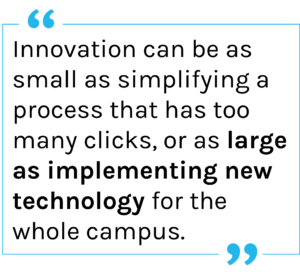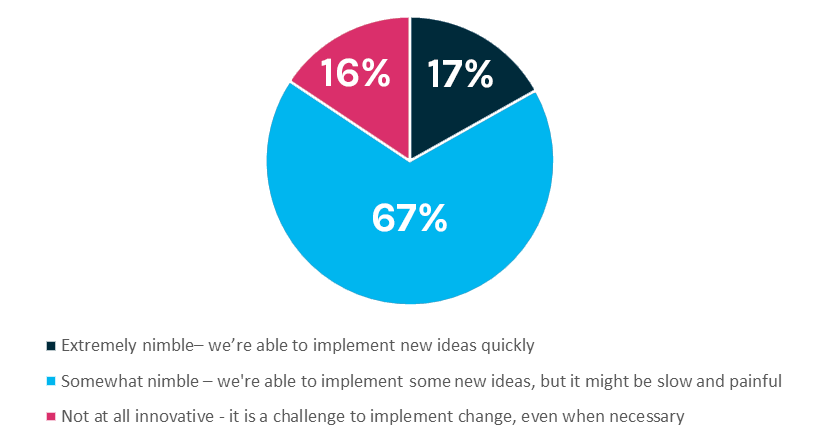HigherEd can look to community colleges for innovation inspiration. 
Community colleges are facing many of the same challenges as four-year colleges and universities. In our recent webinar, “Community Colleges as Centers of Innovation: Shaping the Future of HigherEd,” we checked in with community college technology, change management, and innovation leaders to discuss their top tips and best practices for tackling the greatest HigherEd challenges of today. Check out some key takeaways below and watch the full webinar on-demand.
Take advantage of technology to help solve problems.
C. Edward Watson, Associate Vice President for Curricular and Pedagogical Innovation at the American Association of Colleges and Universities, noted that the three big challenges he’s seeing for HigherEd right now are enrollment, quality educational outcomes, and affordability. There are technological tools that can help institutions tackle all of these problems—the key is to take advantage of that technology and develop a portfolio of solutions that speak to the challenges at your institution.
Some institutions, for example, are working to improve their student advising strategies with new analytics and unique dashboards that can track student progress not just across the years, but within semesters and courses. Alongside predictive analytics, this can help advisors offer better support to students.
The right technology can also solve multiple problems at once. A great example is Open Education Resources (OER), a public digital library which levels the academic playing field, increases affordability, closes equity gaps, and often improves learning outcomes. Don’t be afraid to experiment with technology if your institution can afford it, and make sure you’re paying attention to what’s out there!
Don’t be intimidated by innovation.
Natalie Presta, Ed.D., Director of Information Systems at Feather River College, says, “Don’t let the idea of innovation intimidate you.” She notes that innovation doesn’t have to be huge. Even if you’re developing a one- or five-year plan, you can break that out into sprints to chip away at smaller steps.
 Innovation can be something as small as simplifying a process that has too many clicks, or as large as implementing a new technology for the whole campus. Especially for a small staff, it can be overwhelming—there’s no secret to innovation, but the best way to dive in is to make a realistic plan by evaluating what’s important, where your institution wants to go, and what your capacity is. What steps can you take in a month? In a year? With a plan broken into smaller pieces—and by grabbing the low-hanging fruit first—innovation can feel more doable and closer to home.
Innovation can be something as small as simplifying a process that has too many clicks, or as large as implementing a new technology for the whole campus. Especially for a small staff, it can be overwhelming—there’s no secret to innovation, but the best way to dive in is to make a realistic plan by evaluating what’s important, where your institution wants to go, and what your capacity is. What steps can you take in a month? In a year? With a plan broken into smaller pieces—and by grabbing the low-hanging fruit first—innovation can feel more doable and closer to home.
Be nimble and responsive.
Shelley Yohnka, Director of Human Resources at Lake Tahoe Community College, thinks of recruitment and hiring as a living process. As a community college that has to follow certain state and federal processes and guidelines in hiring, Shelley’s team sometimes loses candidates to the faster hiring processes of the hospitality businesses surrounding her campus in Lake Tahoe.
Even working within regulations, she says it’s important to listen and respond to what’s happening. If you’re losing candidates during a certain step of the process, revisit the rules and policies you’re following to see where improvements can be made. “Just because you’ve always done it one way, doesn’t mean you should always do it that same way,” says Shelley.
Implementing innovation in HigherEd
We polled attendees on how nimble they feel their institutions are when it comes to innovation and implementing change. The results below were enlightening. Most respondents feel that implementing innovation and new ideas is a slow, painful process. But it’s clear that agility is vital in responding to HigherEd challenges. For more tips on how you can encourage innovation and responsiveness at your institution, watch the full webinar here.
